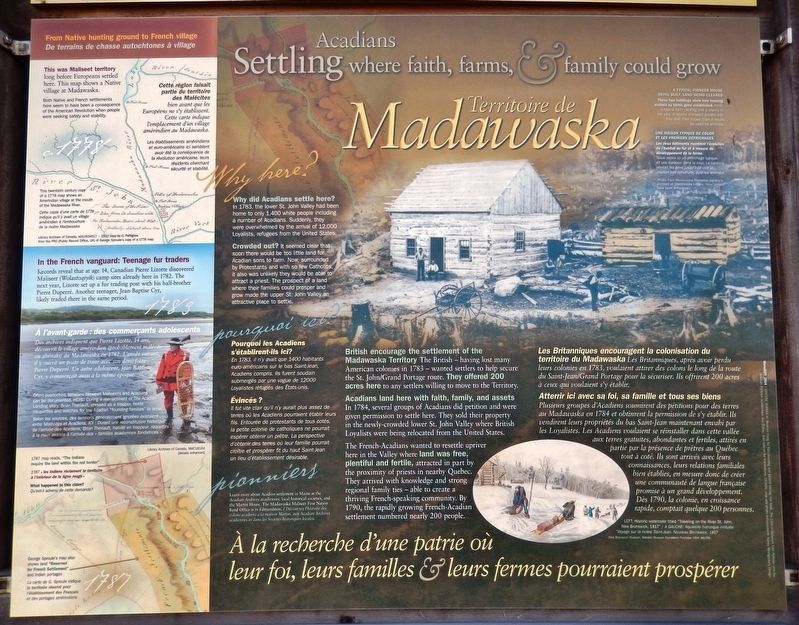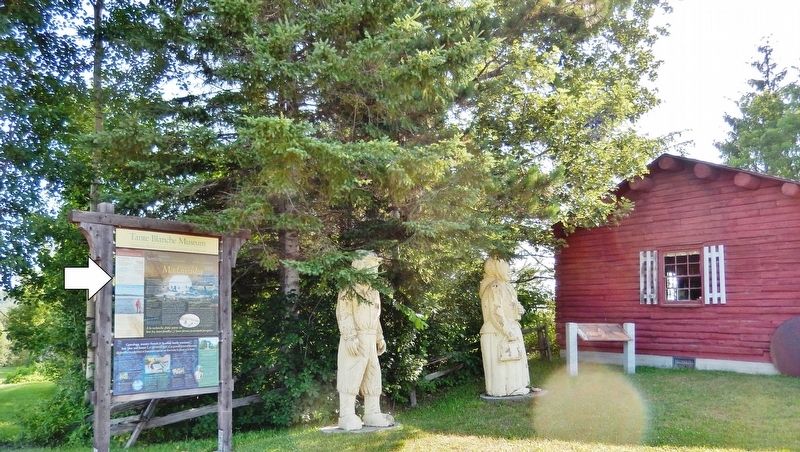Madawaska in Aroostook County, Maine — The American Northeast (New England)
Territoire de Madawaska
—Acadians settling where faith, farms, and family could grow—
British encourage the settlement of the Madawaska Territory.
The British — having lost many American colonies in 1783 — wanted settlers to help secure the St. John/Grand Portage route. They offered 200 acres here to any settlers willing to move to the Territory.
Acadians land here with faith, family, and assets.
In 1784, several groups of Acadians did petition and were given permission to settle here. They sold their property in the newly-crowded lower St. John Valley where British Loyalists were being relocated from the United States.
The French-Acadians wanted to resettle upriver here in the Valley where land was free, plentiful and fertile, attracted in part by the proximity of priests in nearby Quebec. They arrived with knowledge and strong regional family ties — able to create a thriving French-speaking community. By 1790, the rapidly growing French-Acadian settlement numbered nearly 200 people.
Why did Acadians settle here?
In 1783, the lower St. John Valley had been home to only 1,400 white people including a number of Acadians. Suddenly, they were overwhelmed by the arrival of 12,000 Loyalists, refugees from the United States.
Crowded out?
It seemed clear that soon there would be too little land for Acadian sons to farm. Now, surrounded by Protestants and with so few Catholics, it also was unlikely they would be able to attract a priest. The prospect of a land where their families could prosper and grow made the upper St. John Valley an attractive place to settle.
Pioneers
Learn more about Acadian settlement in Maine at the Acadian Archives acadiennes, local historical societies, and the Martin House. The Madawaska Maliseet First Nation Band Office is in Edmundston.
—À la recherché d’une patrie où leur foi, leurs familles & leurs fermes pourraient prospérer—
Les Britanniques encouragent la colonisation du territoire du Madawaska.
Les Britanniques, après avoir perdu leurs colonies en 1783, voulaient attirer des colons le long de la route du Saint-Jean/Grand Portage pour la sécuriser. Ils offrirent 200 acres à ceux qui voulaient s'y établir.
Atterrir ici avec sa foi, sa famille et tous ses biens.
Plusieurs groupes d'Acadiens soumirent des pétitions pour des terres au Madawaska en 1784
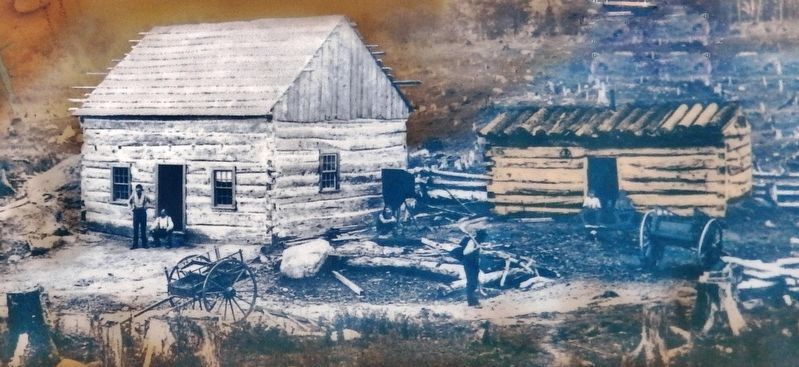
Courtesy Madawaska Historical Society Archives
2. Marker detail: Typical Pioneer House /
Maison Typique de Colon
Maison Typique de Colon
A typical pioneer house being built, land being cleared. These two buildings show how housing evolved as farms grew established. Here, a typical farm clearing and a shanty in the yard. A shanty sheltered people until they built their house, then it would be used for animals.
Une maison typique de colon et les premiers défrichages. Les deux bâtiments montrent l’évolution de l'habitat au fur et à mesure du développement de la ferme. Nous avons ici un défrichage typique, et une baraque dans la cour. La baraque abritait les gens jusqu'à ce que la maison soit construite, puis les animaux.
Une maison typique de colon et les premiers défrichages. Les deux bâtiments montrent l’évolution de l'habitat au fur et à mesure du développement de la ferme. Nous avons ici un défrichage typique, et une baraque dans la cour. La baraque abritait les gens jusqu'à ce que la maison soit construite, puis les animaux.
Pourquoi les Acadiens s'établirent-ils ici?
En 1783, il n'y avait que 1400 habitants euro-américains sur le bas Saint-Jean, Acadiens compris. Ils furent soudain submergés par une vague de 12000 Loyalistes réfugiés des États-unis.
Évincés?
Il fut vite clair qu'il n'y aurait plus assez de terres où les Acadiens pourraient établir leurs fils. Entourée de protestants de tous cotés, la petite colonie de catholiques ne pourrait espérer obtenir un prêtre. La perspective d'obtenir des terres où leur famille pourrait croître et prospérer fit du haut Saint-Jean un lieu d'établissement désirable.
Pionniers
Découvrez l’histoire des colons acadiens à la maison Martin, aux Acadian Archives acadiennes et dans les Sociétés historiques locales.
Erected 2014
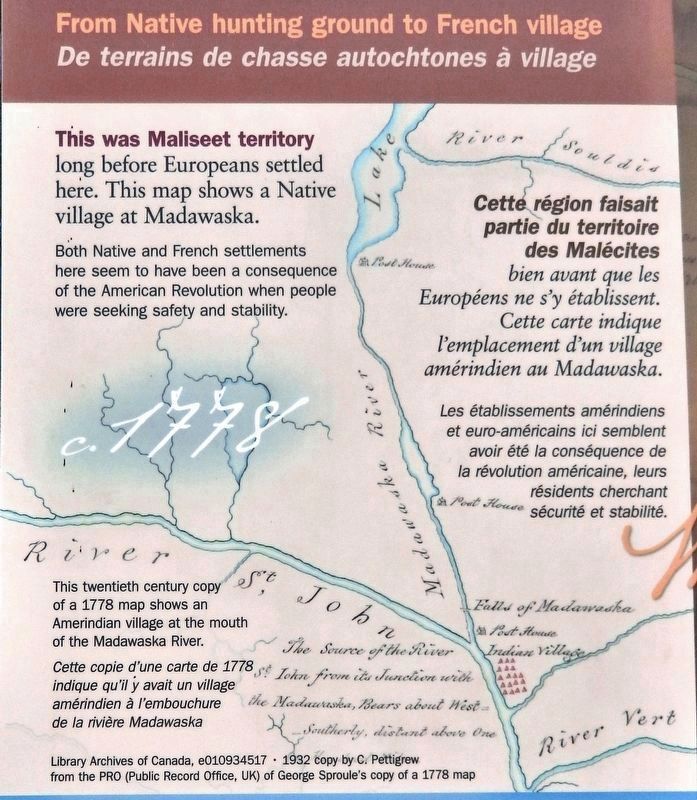
Courtesy Library Archives of Canada
3. Marker detail: 1778 Madawaska Map
Topics. This historical marker is listed in these topic lists: Colonial Era • Settlements & Settlers. A significant historical year for this entry is 1783.
Location. 47° 20.938′ N, 68° 16.581′ W. Marker is in Madawaska, Maine, in Aroostook County. Marker is on Main Street (U.S. 1) just west of Fournier Siding, on the right when traveling west. Marker is the top panel of an interpretive kiosk located on the west side of the Tante Blanche Museum. Touch for map. Marker is at or near this postal address: 774B Main Street, Madawaska ME 04756, United States of America. Touch for directions.
Other nearby markers. At least 8 other markers are within walking distance of this marker. Genealogy, Massive French & Acadian Family Reunions (here, next to this marker); Acadian Heroine: Tante Blanche / Tante Blanche : Héroïne acadienne (here, next to this marker); Du Premier Débarquement des Acadiens àu Madawaska (a few steps from this marker); Discover Traces of Acadian Architecture (a few steps from this marker); "Making Do" / Tout faire avec rien (within shouting distance of this marker); Who is a patenteux? / Patenteux ou pas ? (within shouting distance of this marker); Saint David Catholic Church (about 300 feet away, measured in a direct line); Acadian Landing Site (approx. 0.3 miles away). Touch for a list and map of all markers in Madawaska.
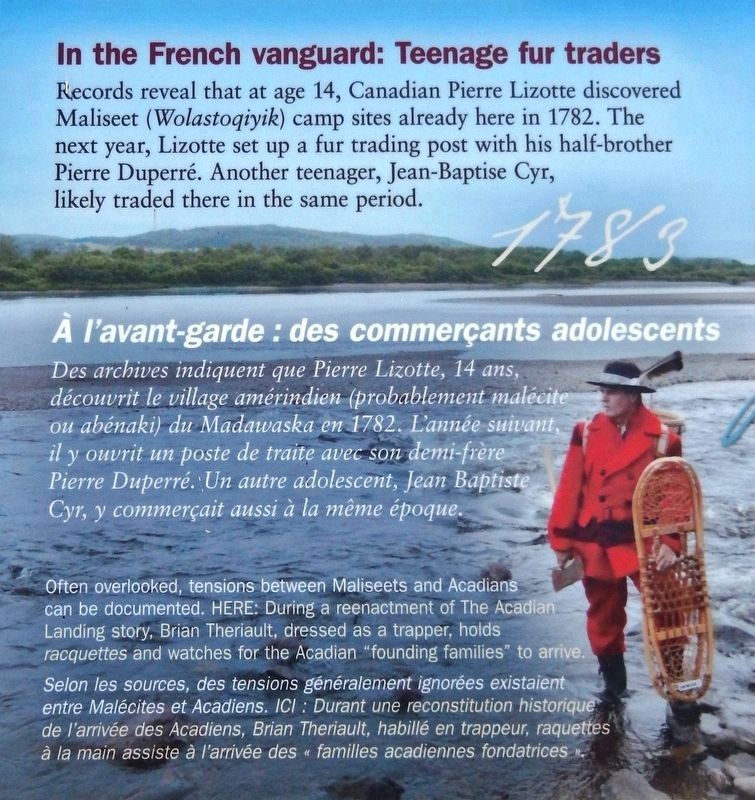
4. Marker detail: Teenage fur traders /
des commerçants adolescents
des commerçants adolescents
Often overlooked, tensions between Maliseets and Acadians can be documented. HERE: During a reenactment of The Acadian Landing story, Brian Theriault, dressed as a trapper, holds racquettes and watches for the Acadian "founding families" to arrive.
Selon les sources, des tensions généralement ignorées existaient entre Malécites et Acadiens. ICI : Durant une reconstitution historique de l'arrivée des Acadiens, Brian Theriault, habillé en trappeur, raquettes à la main assiste à l'arrivée des « familles acadiennes fondatrices ».
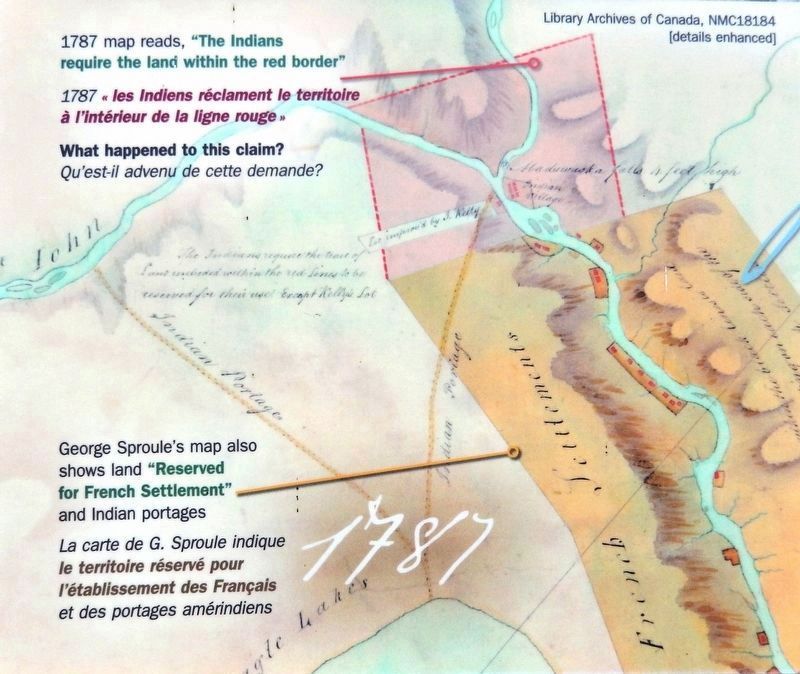
Courtesy Library Archives of Canada
5. Marker detail: 1787 Map
1787 map reads, "The Indians require the land within the red border"
What happened to this claim?
George Sproule's map also shows land "Reserved for French Settlement" and Indian portages
1787 « les Indiens réclament le territoire à l'intérieur de la ligne rouge »
Qu'est-il advenu de cette demande?
La carte de G. Sproule indique le territoire réservé pour l'établissement des Français et des portages amérindiens
What happened to this claim?
George Sproule's map also shows land "Reserved for French Settlement" and Indian portages
1787 « les Indiens réclament le territoire à l'intérieur de la ligne rouge »
Qu'est-il advenu de cette demande?
La carte de G. Sproule indique le territoire réservé pour l'établissement des Français et des portages amérindiens
Credits. This page was last revised on April 16, 2020. It was originally submitted on April 15, 2020, by Cosmos Mariner of Cape Canaveral, Florida. This page has been viewed 266 times since then and 21 times this year. Photos: 1, 2, 3, 4, 5, 6. submitted on April 16, 2020, by Cosmos Mariner of Cape Canaveral, Florida.
